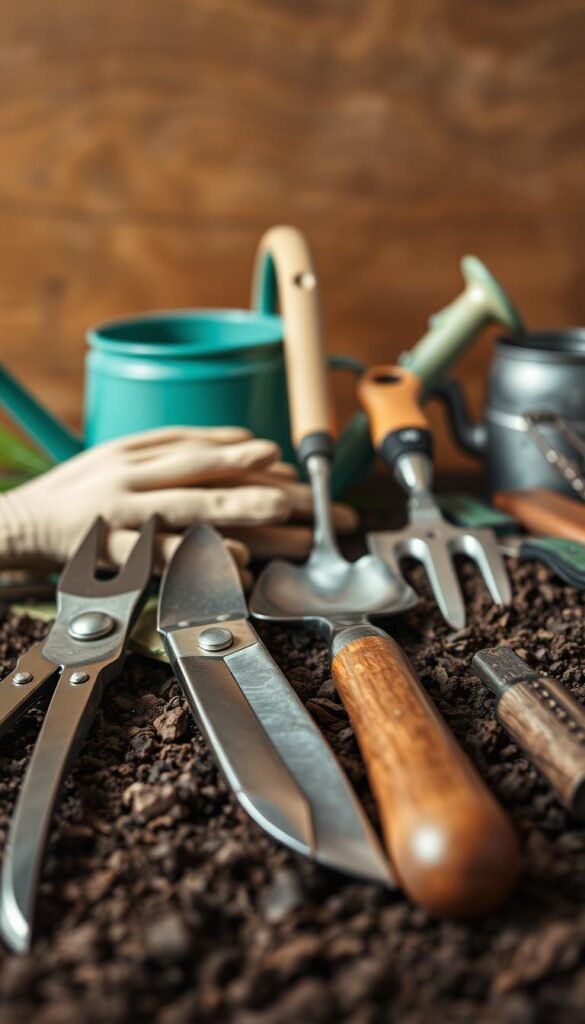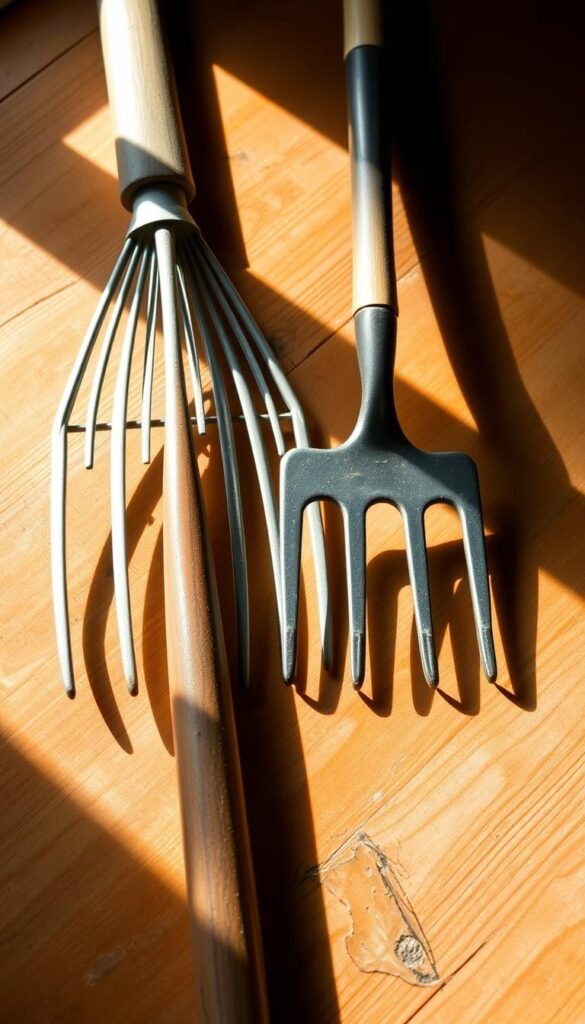Starting a new hobby in the yard? The right equipment can turn overwhelming tasks into joyful moments. A well-organized shed with practical, durable items helps you work smarter—not harder—while connecting with nature.
Many new enthusiasts make one big mistake: buying too much too soon. Overcrowded storage spaces and unused gadgets waste money and create clutter. Instead, focus on versatile tools that handle multiple jobs. Quality matters—sturdy materials last longer and perform better, saving you replacement costs.
This guide cuts through the noise. You’ll learn which 12 items deserve your investment and why maintenance habits extend their lifespan. Forget flashy gadgets; we’ll prioritize what truly matters for planting, pruning, and nurturing your green space.
Ready to build a toolkit that grows with your skills? Let’s explore how simplicity and smart choices set you up for success.
Getting Started with Your Garden
Creating your green oasis begins with smart planning. Observe your area’s sunlight patterns and water sources before picking up any equipment. A sunny patio needs different care than shaded backyard corners.
Understanding Your Space and Soil
Test your dirt’s texture by squeezing a handful. Clay clumps tightly? You’ll need sturdy tools for breaking through tough layers. Sandy soil crumbles easily? Opt for lightweight gear that preserves its delicate balance.
Track how water pools after rain. Low spots might drown plants if not addressed. Note where shadows fall at noon—this affects what thrives in each zone.
Setting Clear Garden Goals
Dreaming of fresh tomatoes? A vegetable garden demands durable shovels and wide beds. Prefer low-maintenance blooms? Compact hand tools simplify daily care.
Be honest about your schedule. Busy lives pair best with drought-resistant varieties and drip irrigation systems. Start small—three herb pots teach more than an acre of untended rows.
Essential Protective Gear and Safety Tips

Your hands work hard in the dirt, making protection a non-negotiable part of yard work. Sharp thorns, rough surfaces, and repetitive motions demand gear that shields without limiting mobility. Start with the basics—smart choices here prevent injuries and keep tasks enjoyable.
Choosing the Right Gardening Gloves
A good pair of gloves acts like armor for your most valuable gardening tools—your hands. Look for snug-but-flexible designs that balance durability with sensitivity. Water-resistant palms handle muddy jobs, while breathable backs prevent sweaty discomfort during long sessions.
Snug-fitting gloves prevent slips when handling sharp tools or delicate seedlings. Extra-long cuffs block dirt from sneaking in and protect wrists from scratches. Consider keeping two pairs: rugged ones for digging and lightweight options for precise tasks like planting basil seeds.
Simple Safety Practices for Outdoor Tasks
Stay sun-smart with wide-brimmed hats and UV-protective clothing. Keep a water bottle nearby—hydration boosts focus and prevents fatigue. Always inspect tools for rust or damage before use, especially pruners and shears.
Store gloves upside-down after use to shake out debris, and air-dry them away from direct sunlight. A quick rinse removes dirt that can degrade fabrics over time. Remember: clean, dry gear lasts longer and works better.
Must-Have Hand Tools for Everyday Gardening

Your green space thrives when equipped with reliable companions. These compact helpers tackle everything from delicate planting tasks to stubborn weeds, becoming extensions of your hands. Let’s explore the champions of daily yard work.
Trowels, Forks, and Cultivators Explained
A trusty trowel acts like a pocket-sized shovel. Broad blades scoop soil quickly for transplanting basil, while narrow designs pry rocks from tight spaces. The Garrett Wade Tulip Trowel slices through roots effortlessly—perfect for bulb holes or tree bases.
Three-pronged cultivators aerate packed earth and uproot young weeds. “Think of them as mini-rakes,” says Oregon landscaper Mia Torres. “They prep seedbeds without disturbing nearby roots.” Forks lift plants gently during division, their curved tines cradling root balls.
How to Pick the Perfect Hand Tools for Your Garden
Prioritize these features:
- Stainless steel blades that resist rust and sharpen easily
- Ergonomic handles shaped for your palm size
- Visible measurement marks for consistent planting depth
Test grip comfort by mimicking digging motions. Tools should feel like natural extensions, not awkward add-ons. Avoid hollow handles—solid rubber or wood absorbs vibration better during long sessions.
Remember: Quality construction prevents snapped joints. That bargain-bin fork might crumble when confronting clay soil. Invest once in tools that evolve with your skills.
In-Depth Look at Pruning and Cutting Tools

Sharp edges make all the difference when shaping plants or removing unwanted growth. The right cutting tools act like surgical instruments for your green space, promoting faster healing and healthier growth.
Hand Pruners: The Surgeon’s Scalpel
Compact and mighty, these fit snugly in your palm for precise work. Bypass models work like scissors—their curved blades slice cleanly through living stems. “They’re perfect for roses or harvesting veggies without bruising tender stalks,” notes Portland gardener Elena Martinez.
Anvil-style pruners crush rather than slice. Use them only on dead branches—their straight blade meets a flat plate, risking damage to fresh growth. For arthritis-friendly options, ratcheting mechanisms multiply power with each squeeze.
Reaching New Heights with Loppers
When branches thicken beyond ½ inch, upgrade to long-handled loppers. Their leverage tackles tough jobs:
| Feature | Bypass Loppers | Anvil Loppers |
|---|---|---|
| Best For | Live branches | Deadwood |
| Cut Quality | Smooth edge | Crushed edge |
| Weight | Lighter (aluminum) | Heavier (steel) |
Carbon-composite handles reduce arm fatigue during extended pruning sessions. Always match tool length to your reach—overly long handles strain shoulders.
Keep blades razor-sharp using a diamond file. Wipe them with rubbing alcohol between plants to prevent disease spread. For more maintenance hacks, check our starter checklist.
Rakes, Spades, and Forks: Tools for Soil and Debris Management

Seasonal cleanups become effortless with the right trio of tools. These heavy-lifters handle everything from autumn leaf piles to spring soil prep, keeping your outdoor space functional year-round.
The Versatility of Garden Forks and Spades
Adjustable rakes like the Tabor Tools model adapt to any task. Collapsed to 8 inches, they slip between shrubs. Expanded to 23 inches, they conquer sprawling leaves quickly. Steel tines tackle tough debris, while plastic versions protect delicate grass.
| Rake Type | Best For | Durability |
|---|---|---|
| Steel Tines | Heavy debris | 10+ years |
| Plastic Tines | Lawn care | 3-5 years |
| Adjustable | Multi-space use | 7-8 years |
Square-tined forks break through rocky soil where spades falter. “Their curved spines turn compost like professional equipment,” shares urban farmer Diego Rivera. Straight-tine models excel in clay-heavy earth.
Pair your fork with a sharp-edged spade for precision work. The flat blade slices through roots cleanly, creating perfect edges around garden beds. Durable models withstand decades of digging and lifting.
Remember: Match steel tools to tough jobs, plastic to gentle surfaces. Store them dry to prevent rust—your future self will thank you during next season’s big cleanup.
Choosing and Using Watering Equipment
Proper hydration transforms your outdoor space from surviving to thriving. Smart watering tools prevent wasted effort while keeping plants lush. Let’s explore how to deliver moisture where it matters most.
Hoses, Nozzles, and Watering Wands
Rubber hoses outlast vinyl in extreme temperatures. Pair them with brass connectors—they resist leaks better than plastic. Adjustable nozzles let you switch between gentle sprays for seedlings and jet streams for stubborn dirt.
Watering wands extend your reach for hanging baskets or raised beds. Look for models with ergonomic grips and shut-off valves. A 12-inch rose (the perforated head) mimics rainfall, reducing soil disruption.
Tips for Efficient Water Management
Water before 10 AM to minimize evaporation. Focus on root zones—surface sprinkling encourages shallow roots. Drip systems target thirsty plants without wetting leaves, cutting disease risks.
Group vegetation by water needs to avoid overwatering drought-tolerant varieties. Use a moisture meter weekly; many plants prefer slightly dry soil. Collect rainwater in barrels during spring storms for summer dry spells.
Remember: Consistent hydration beats frequent drenching. Your tools should simplify routines, not complicate them. With the right setup, you’ll nurture growth while conserving resources.






